Disclosure: My website is reader supported. If you choose to buy a product after clicking a link, I may earn a commission, at no extra cost to you. Learn more.
Overview
I tested five white noise machines, a white noise app on my phone, a Bluetooth speaker, and a smart speaker to see which is loudest, and how well they mask external noise.
You can watch the full test in the video above, or read the transcript below.
You can also skip to the results section, which includes links to find out more or buy any of the white noise machines.
Video transcript
Please note that I’ve edited the transcript to make it clearer. I’ve also added a few extra notes I thought would be useful.
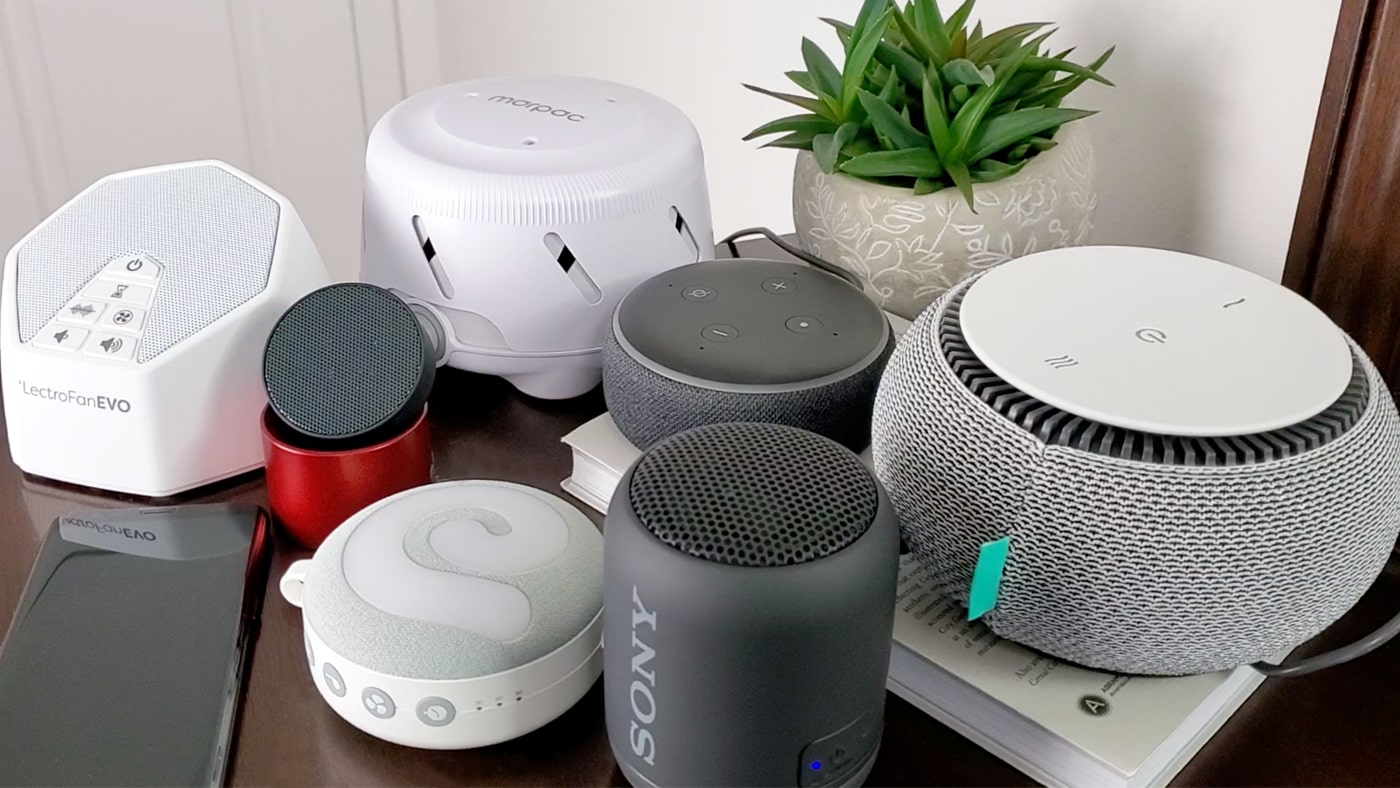
Introduction
This section starts at 0:00 in the video
Hi, I’m Ethan Green from nosleeplesnights.com, and in this video I’m going to be testing and comparing the sound masking effectiveness of five different white noise machines, a smartphone, a Bluetooth speaker connected to a smartphone, and a smart speaker.
The reason I wanted to do this video is that people sometimes ask me why should they buy a white noise machine when they could just use their phone, an app, or even just a speaker that they’ve already got in the house. And it’s actually a really good question.
There are several different reasons, but one of the main ones that I normally give is that a decent white noise machine should have better speaker quality, louder maximum volume, and better overall sound masking than a normal smartphone speaker. However, once you add a Bluetooth speaker, it’s a whole new ball game.
So what I’ve decided to do is a few basic tests in my bedroom to demonstrate exactly what I mean.
My plan for the tests
Not all of these devices have the same sound options. Two, for example, only have an internal fan (the Snooz and Dohm Uno).
So I’m going to choose the sound which I think is going to be the most effective at sound masking for each of these devices and then compare those. I’m going to use a basic decibel meter to measure the highest dBA over a few seconds for each device.
Arguably more importantly, I’m going to take mental notes as to which one seems to be best at blocking out the external world through my bedroom window. In my bedroom, that’s the drone of air conditioning units and some light traffic in the distance.
To make life even harder for each device, I’m also going to play some loud dance music on my tv next door in the living room, which has quite a lot of bass. So it will be very interesting to see if any of them can block that out.
My plan is to put the decibel meter by my pillow on the bed and then have the devices on a table three meters away – basically by the bedroom door in between me and the tv.
And finally, if you’d rather see more information about each individual device and all the features and sound options that they each have then I’ll put links to the reviews that I’ve done in the past. So with that said, let’s get on with the first device.
1. Baseline test: the ambient bedroom noise
This section starts at 1:46 in the video
Okay, here we are in the bedroom. Before we start with the white noise machines let’s have a listen to the ambient room noise. I’ve got my decibel meter here. In a second, I’m going to stop this filming, run next door, turn the tv on so we’ve got the music as well as the ambient noise through the window and have a listen.
So, 43.8 dBA – that’s the baseline. Now let’s get started with the first white noise machine.
Note: if you watch the video you can just about hear the background music coming from the living room, but when I’m talking, you can’t hear it. I did a lot of going backward and forward in the video so that I didn’t have the music playing while I was talking. I then put it all together as best I could when I edited it. Even though I only show the decibel meter for a couple of seconds in each clip, I used it for longer to check I got good readings. I then edited it shorter so as not to make the video too boring!
2. LectroFan Evo white noise machine
This section starts at 2:12 in the video
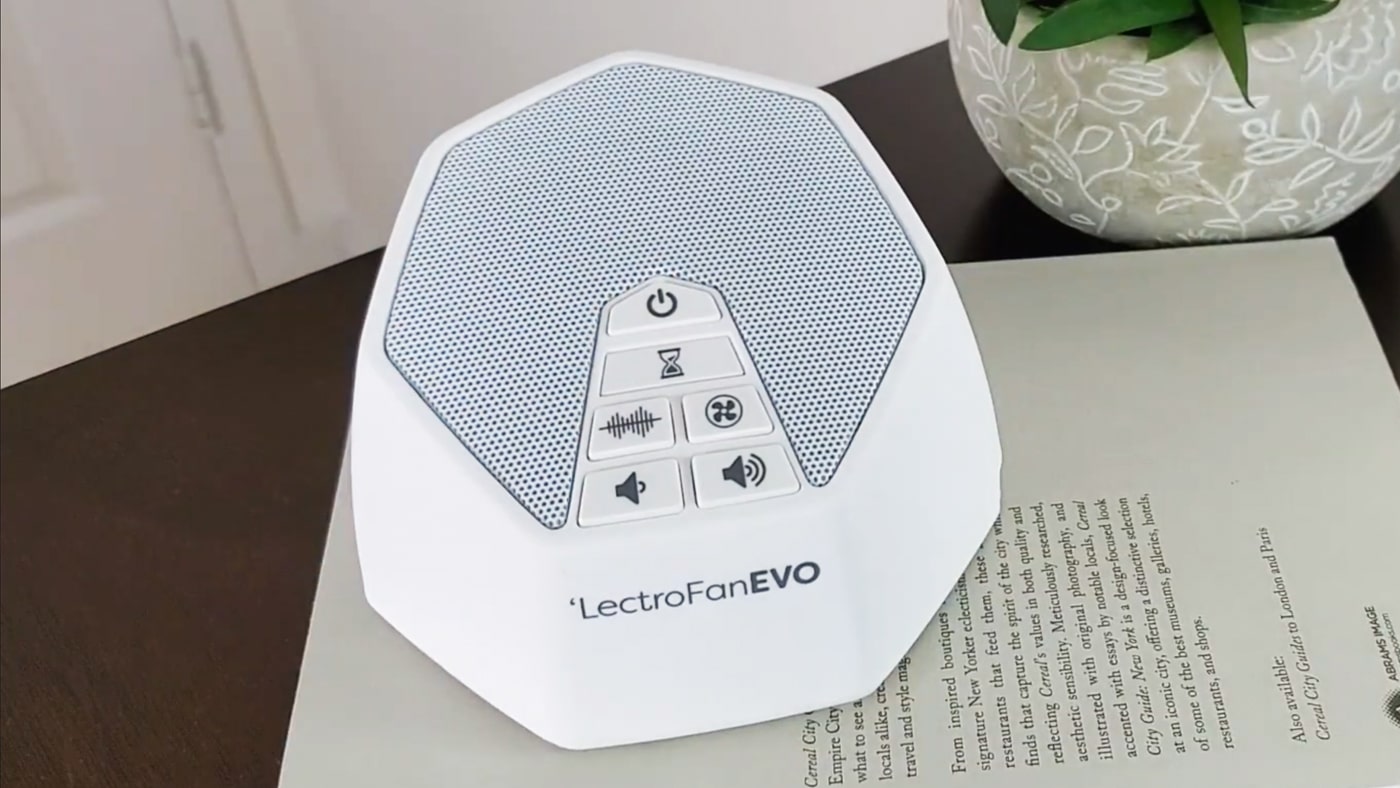
First up then we have the Lectrofan Evo. This is a white noise machine that I’ve got high expectations for where the volume is concerned, and also the sound quality – it’s one that I’ve long recommended. It’s a really good white noise machine as it has a wide range of white noise and fan sounds.
77 dBA. That’s really loud, and it was loud to listen to as well. It did a really good job of blocking out the ambient noise – I can’t hear anything coming through the window.
And where the music is concerned, I can’t really hear all of the music – not the lyrics and some of the treble, but I can hear the bass still. That’s not really a surprise, and it’s going to be very interesting to see if any of these white noise machines block it out. If this one didn’t, I don’t think any of the others will. The Sony speaker coming up is going to be the only one that has a chance for that I think.
If you’d like to find out more about the LectroFan Evo and listen to more of the sounds, you can see my Lectrofan Evo review.
3. Dreamegg D11 white noise machine
This section starts at 3:04 in the video
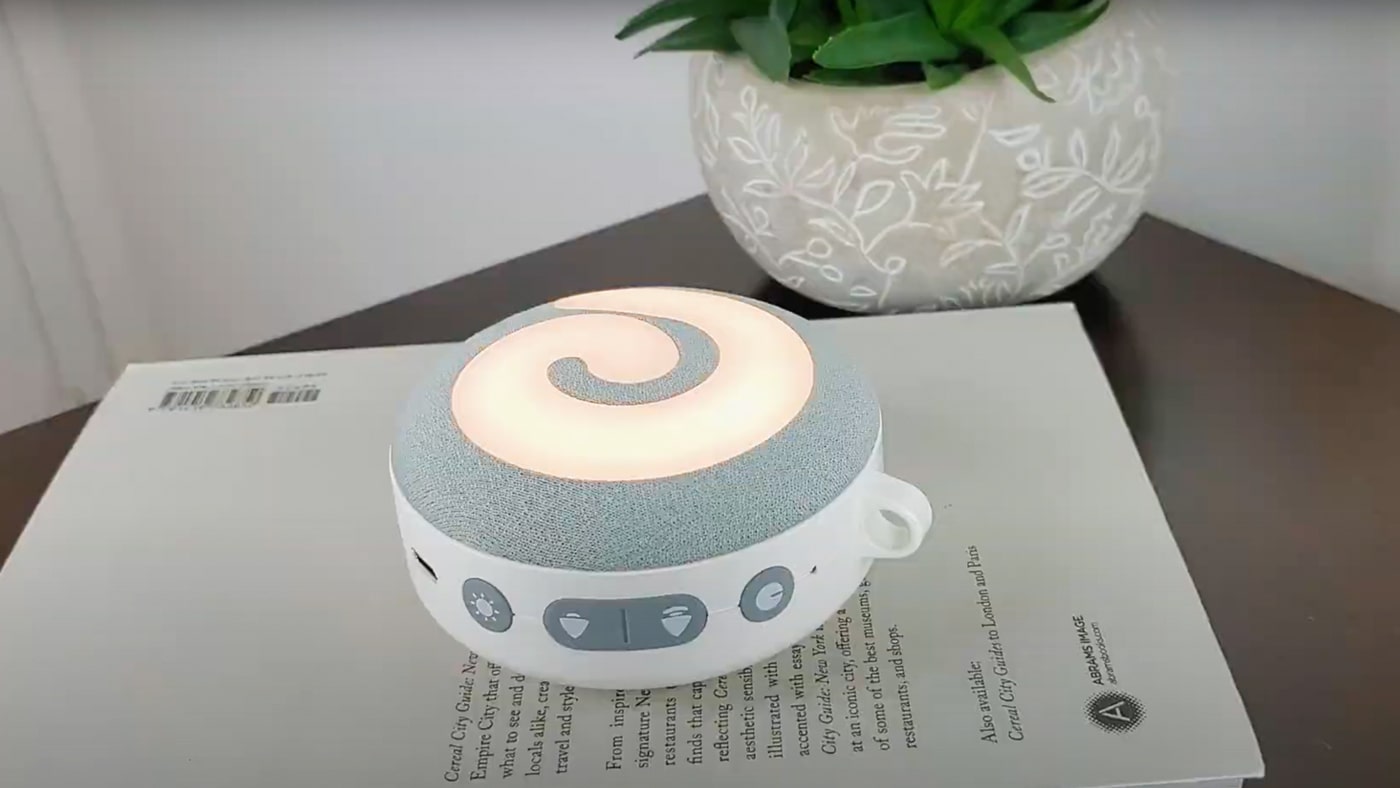
The Dreamegg D11 is a budget white noise machine that doesn’t have that many sound options, so I’m going to put it on the white noise and have a listen.
70.2 dBA – it’s quite loud actually, louder than I was expecting. Nowhere near as loud as the Lectrofan Evo since it is a logarithmic scale. But it’s still louder than I expected for such a small device. It does block out the sound through the window, but I can still hear the bass and a bit of the music coming from next door.
If you’d like to find out more about the Dreamegg D11 and listen to more of the sounds, have a look at my D11 review.
4. Samsung Galaxy S8 phone + ‘white noise generator’ app
This section starts at 3:41 in the video
In this photo, you can see the phone and app combination from the video:
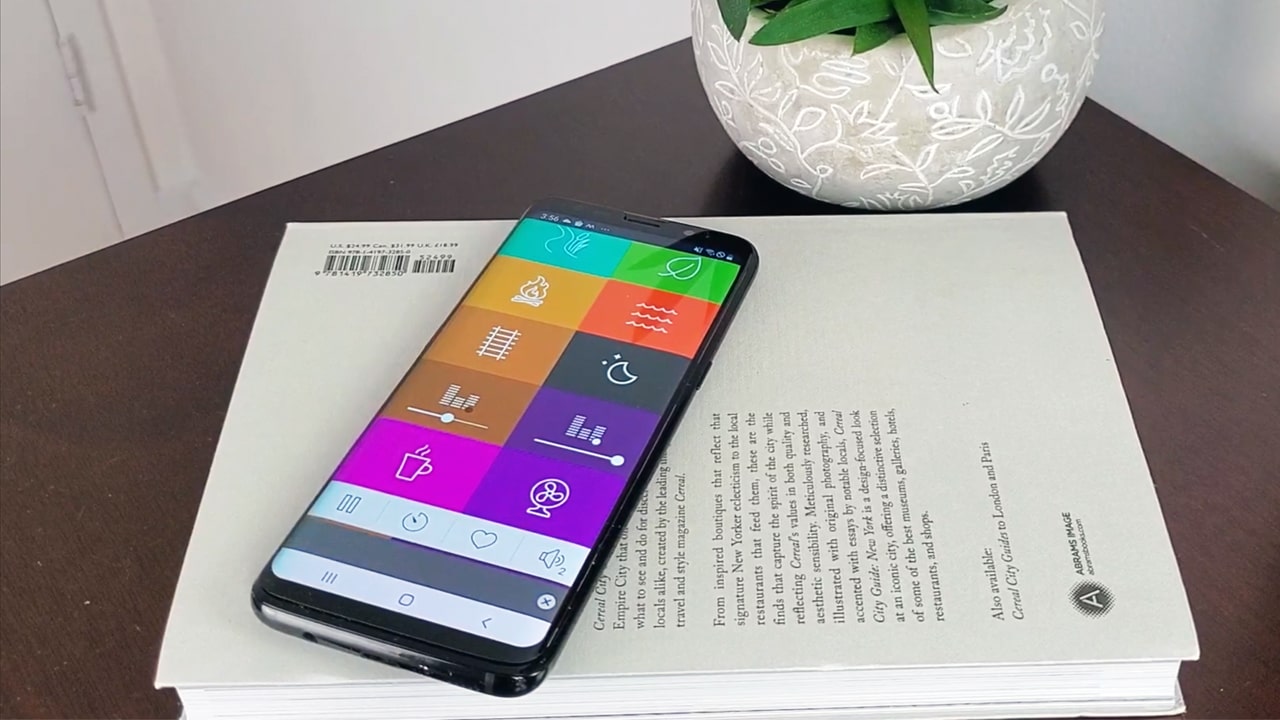
Next up we have the smartphone test, which I imagine many people are going to be interested in. For this one, I’ve got a Samsung Galaxy S8. I didn’t want to use the most recent phone, but not one that’s really old either.
I’m going to use an app that’s simply called ‘white noise generator’. You can find it on the Play store and I think on iTunes as well. I’m not an iPhone user but I suspect that it’s on there as well. What I like about this one is that you can just touch the buttons to choose different noises, and combine them as well, which is what I’m going to do in this test. I’m going to play pink and brown noise at the same time and see how good a job it does of blocking out the noise.
70.9 dBA for the Samsung Galaxy S8, which is actually pretty loud. It’s louder than I was expecting. However, it didn’t do a very good job of blocking the music from next door. I could still hear the lyrics and I could still hear the bass. So even though it’s quite loud, I think the sound was quite directional. I had it on the table and it’s pointing toward me, so perhaps it just didn’t fill the room with the same sound masking white noise as some of the other devices do. The next interesting test is going to be to connect that to a Bluetooth speaker and see what difference it makes.
Note: To find the app I used, just search for ‘white noise generator’ on the Play store. I said in the video I think it’s available on the Apple store too, but I don’t think it is now. There are many white noise apps on both stores to choose from though. I chose this one for the test because I like the visual simplicity.
I don’t include a link here to buy the phone as I know most people get their phone on contract. But in case you’re interested, I actually bought a refurbished one for half the normal price and was very happy with it.
5. Sony SRS-XB12 Bluetooth speaker + Samsung Galaxy S8 phone + ‘white noise generator’ app
This section starts at 4:51 in the video
In the photo below you can see the exact setup I used in the video test – the Sony Bluetooth speaker connected to my Samsung Galaxy S8 and the white noise generator app:
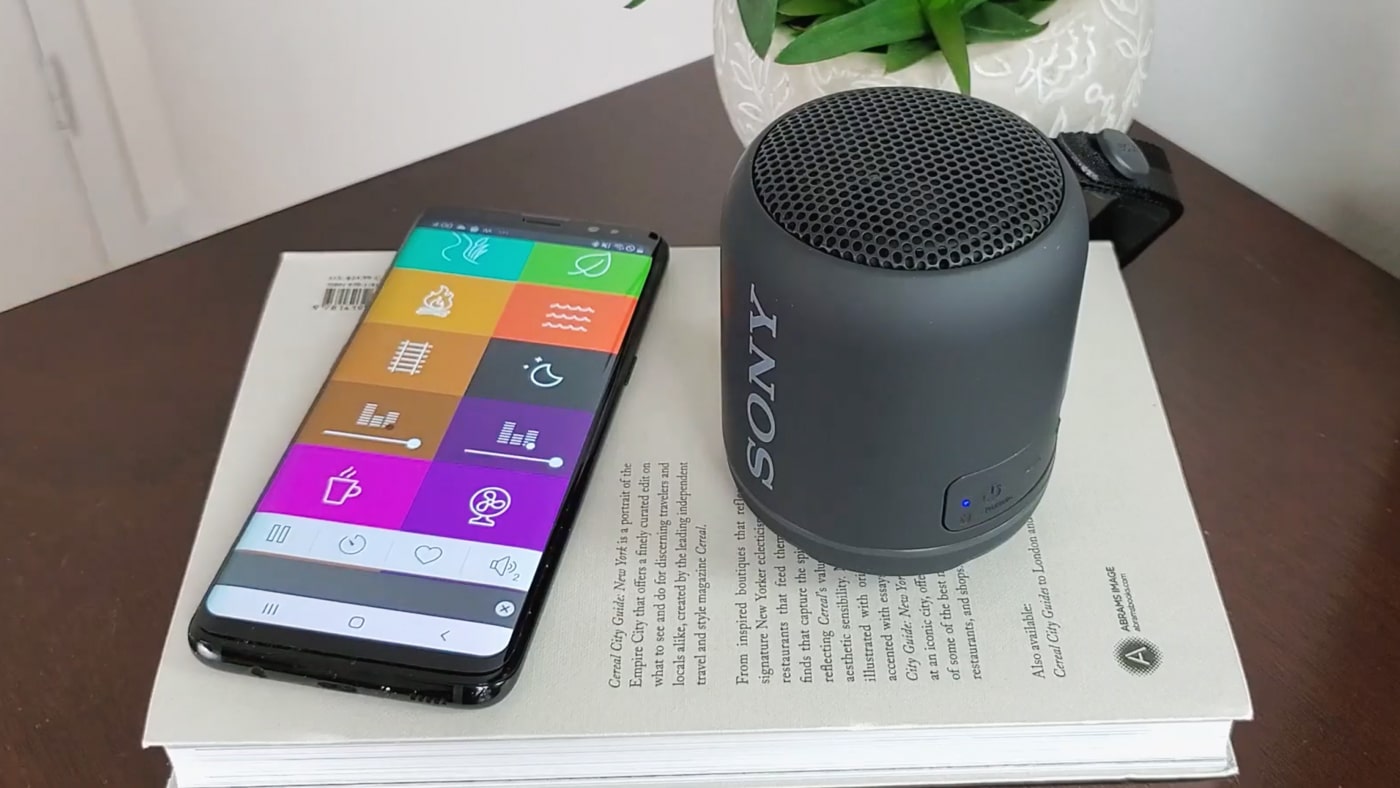
For this next test, I’m going to use the same phone and the same app, and the same settings, but I’m going to connect it and play it to my Sony SRS-XB12. This is a Bluetooth speaker which I’ve chosen specifically because it’s a similar size to the white noise machines. It’s quite portable and isn’t particularly heavy. It’s also a similar price to some of the white noise machines.
I didn’t want to go ahead and buy the world’s most expensive speakers because I just don’t want to buy one. I don’t need one and also I think it would be an unfair comparison. I think it’s quite obvious that if you connect some incredible Sonos speakers onto your walls and then play white noise through them, it’s going to blow these machines out of the water.
Note: I’ve tested this in someone’s house who has a lot of Sonos speakers, and it’s unpleasantly loud on max volume. Waterfalls, ocean waves, rain, and thunder sound awesome though!
But if you’re someone that’s on a lower budget and you don’t want to spend hundreds and hundreds on the world’s best speakers, or thousands, then this is a speaker which you can afford. At the moment I think it’s around 60 dollars (less without the case). So let’s have a listen.
So the Samsung Galaxy phone connected to the Sony Bluetooth speaker idea looks like it was a good one because it came out at 73.6 dBA, which is loud. It’s not as loud as the Lectrofan Evo. But more importantly, it did a really good job of blocking out the music next door. As I was sitting here I couldn’t hear anything – not even the bass.
So for me, it looks like we’ve probably already found a winner in this test with the Bluetooth speaker – very interesting. But let’s find out if the other white noise machines have any chance of blocking out the music to the same extent that this one did.
Note: since filming, I’ve continued to use this little speaker in my home office and like it a lot. So if you’re thinking of getting a reasonably priced, decent Bluetooth speaker, I definitely recommend putting this one on your shortlist when you shop around.
6. Lectrofan Micro 2 white noise machine
This section starts at 6:19 in the video
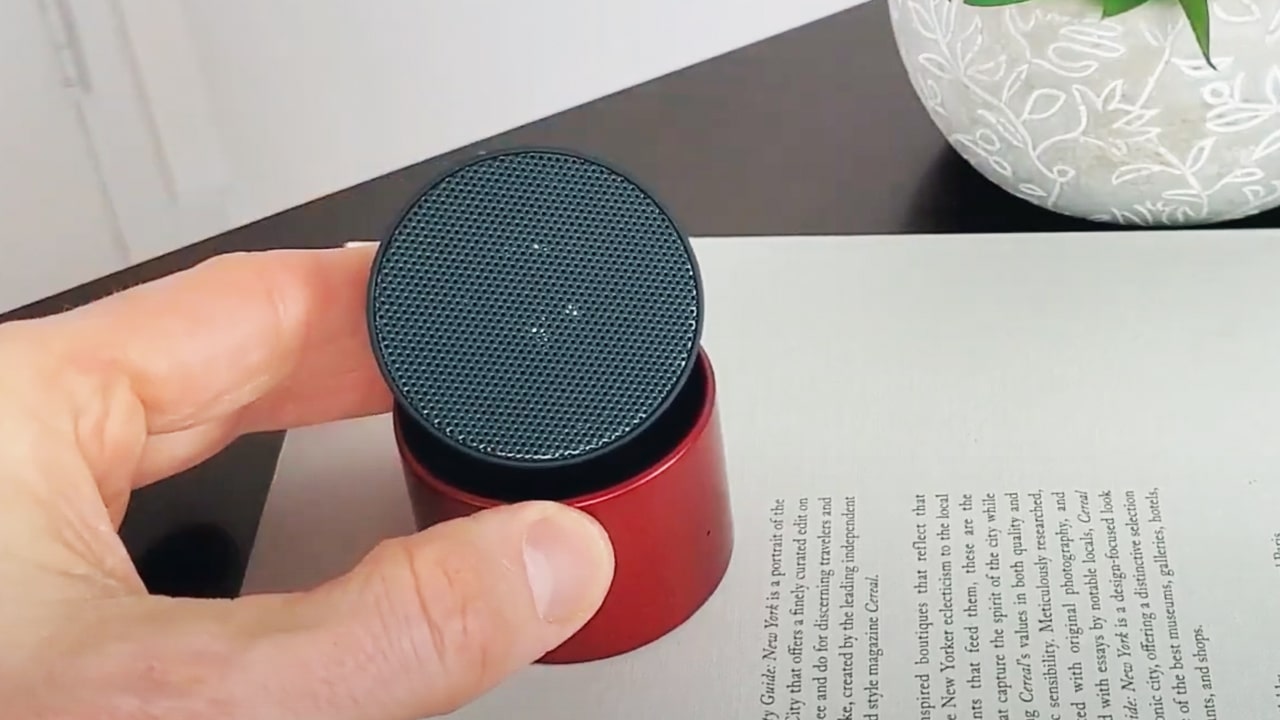
Next up we have the tiny little Lectrofan Micro 2. I thought I’d include this one just to see what difference it makes if you use one of the smallest white noise machines that are out there.
I’m not expecting particularly loud volume or great sound masking from this one, but I am expecting something because I quite like this little speaker. It’s a good one for portability and it does have some decent sound options. So let’s have a listen.
69.3 dBA for the Lectrofan Micro 2, which isn’t as loud as the others so far, but it’s pretty good I thought considering its size. When it came to blocking out the music next door, I could still hear the bass which is what I expected. But it blocked out everything else and the ambient noise, so it did a pretty good job considering how tiny it is.
If you’d like to find out more and listen to the sounds, take a look at my full LectroFan Micro 2 review.
7. Snooz white noise machine
This section starts at 7:08 in the video
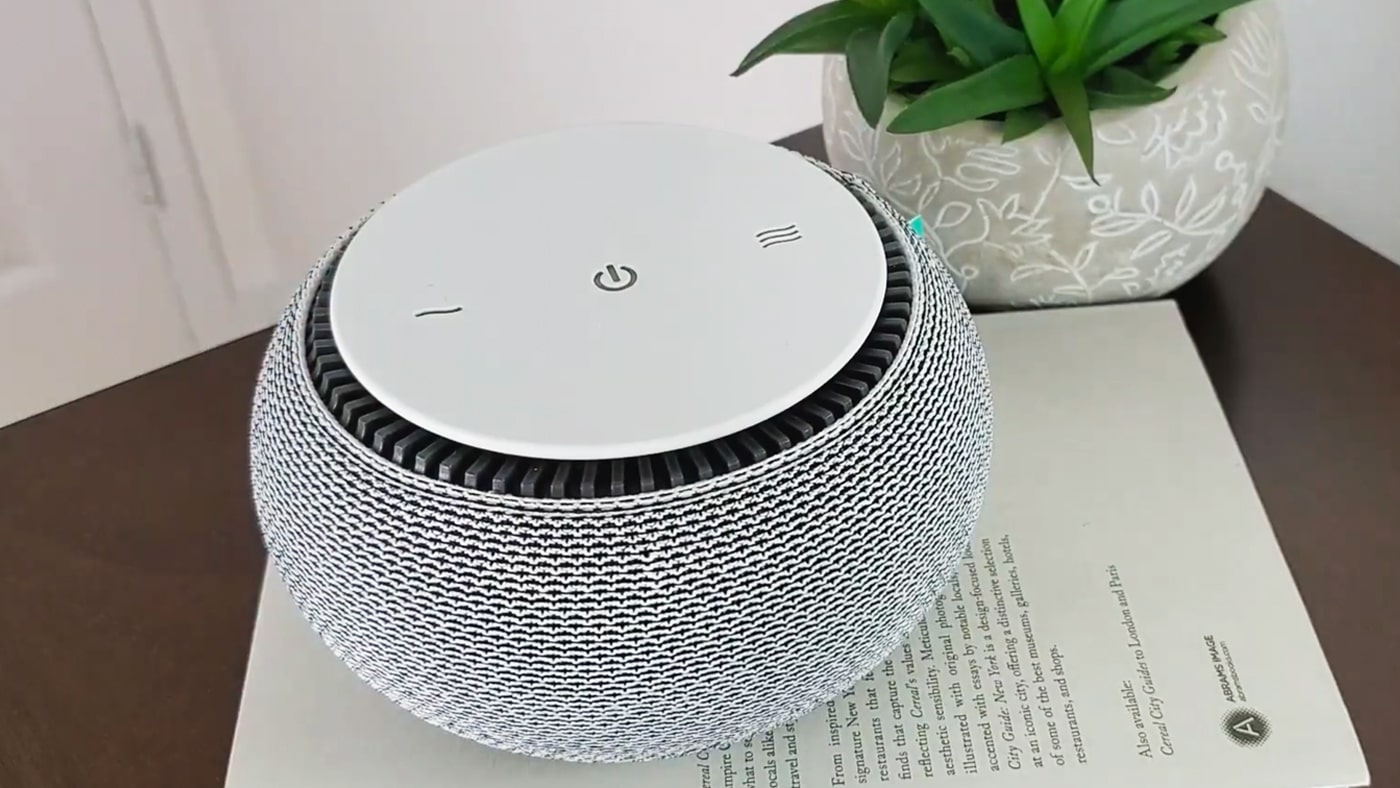
The Snooz is a white noise machine that has an internal fan. There are no recordings and no speaker, so it’s going to be interesting to see if it has any chance of blocking out the sound from next door.
66.4 dBA for the Snooz, which isn’t bad at all. It’s louder than I expected considering it only has an internal fan. But it’s nowhere near as loud as the Lectrofan Evo, for example. It does a good job of blocking out the ambient noise coming through the window – the air conditioning units, but I could hear quite a lot of the music from next door still.
If you’d like to find out more and hear it in action for longer than I demonstrate in the test, have a look at my full Snooz review.
Note: If you like the internal fan style of white noise machines, this is the best one I’ve found so far. However, it’s also the most expensive. I like how it has volume control, which is unusual for fan-based devices, so it has a better chance of masking external noise. But if you’re on a tighter budget, perhaps a machine with recordings for half the price is worth considering too.
8. Dohm Uno white noise machine
This section starts at 7:44 in the video
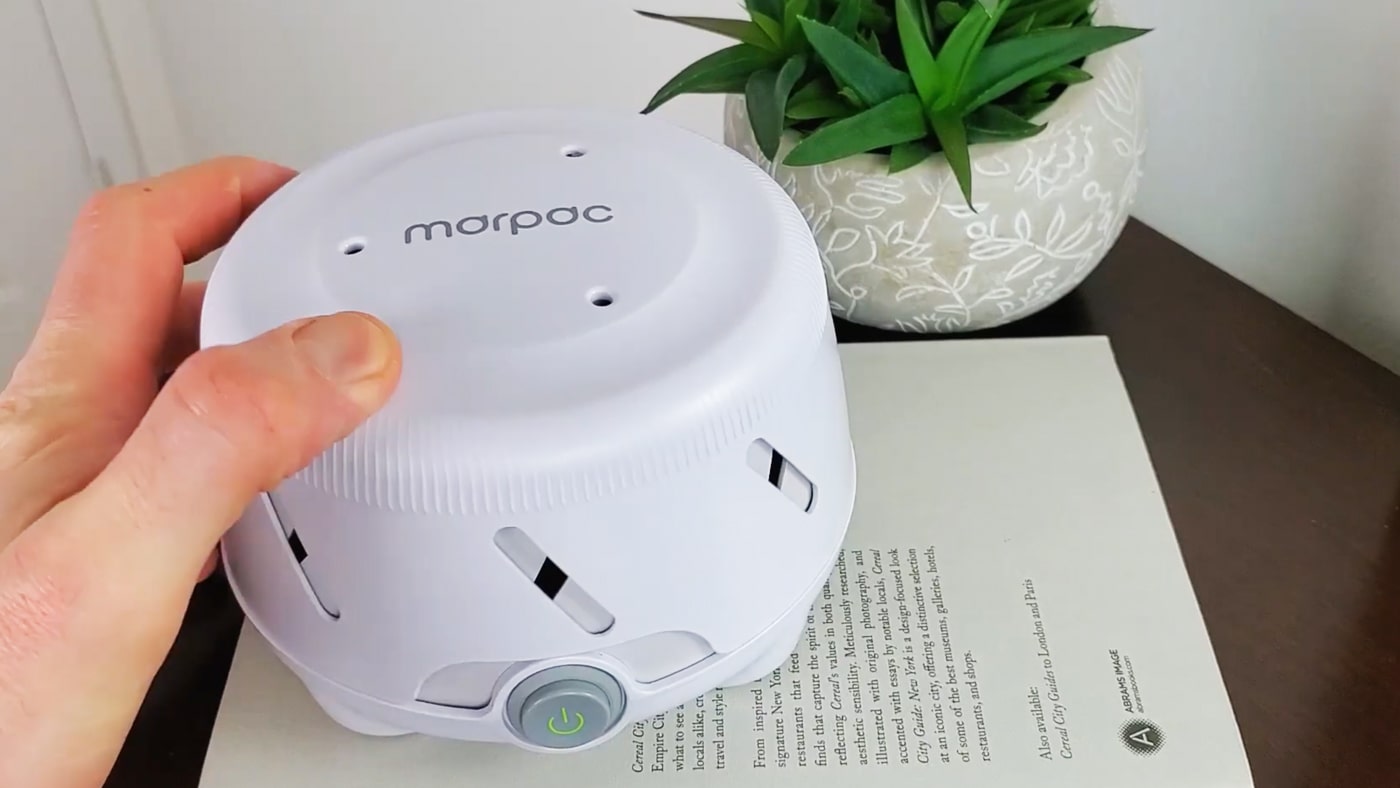
Here we have the Dohm Uno. It’s actually an older model I’m using in the video as it still says Marpac. But Marpac merged with Yoga Sleep, and it’s just the Dohm Uno now. I’m expecting this one to be very quiet as it’s historically a device which is very quiet. It just has an internal fan as well like the Snooz.
55 dBA for the Dohm Uno. That’s the quietest so far, and I suspect it’s going to be the quietest overall. It didn’t do a good job of blocking out the music next door at all. I could hear literally everything. I think you can use it to block out some of the ambient noise from outdoors, but this is one that’s going to be better for relaxation than sound masking if you’ve got a lot of noise to deal with.
If you’d like to find out more about the Dohm Uno, have a look at my comparison of the Dohm Uno and Rohm.
9. Echo Dot 3rd Gen + pink noise from Spotify
This section starts at 8:30 in the video
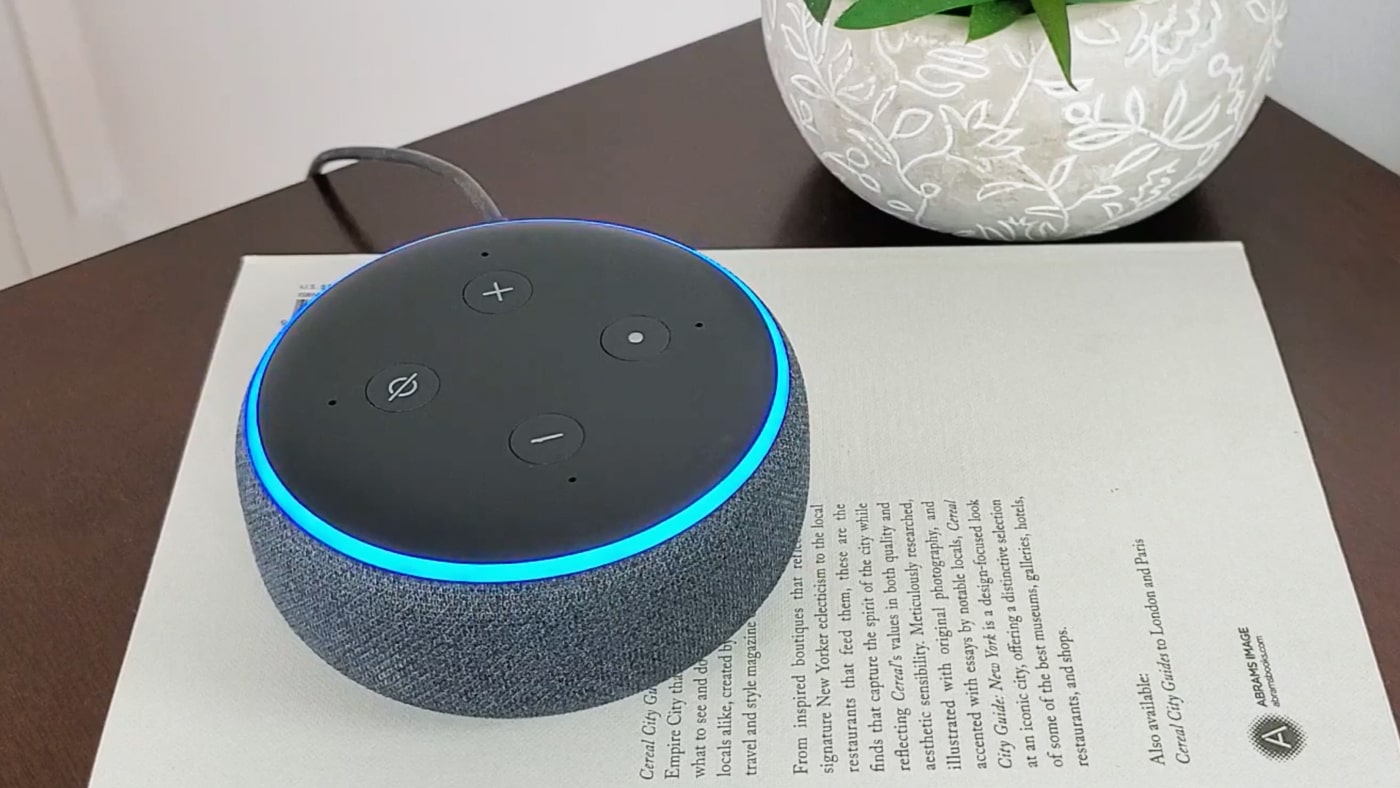
And finally, we have the Echo Dot third generation, which is the smart speaker that I currently use at home. Considering it’s so small, it has a really good speaker. I really like this one – I listen to jazz FM on it a lot while I’m waiting for it to tell me when my egg is boiled and what the temperature is outside!
I think if you’ve got a smart speaker at home, then you probably don’t need to buy a white noise machine if it’s in the room that you already want to listen to white noise, which is why I’ve included it. So let’s have a listen and see if it’s also as good at blocking out music next door as it is at playing me my jazz FM in the morning.
74.2 dBA – that’s a pretty good result for the Echo Dot. It’s very loud and it filled the room with sound as well, so I was quite impressed. It blocked out everything coming through the window and most of the music. But like most of the other devices, it didn’t quite block out the bass for me. But overall, as a smart speaker it did a good job of playing white noise.
Note: I still stand by this idea: if you own a smart speaker, it’s worth seeing if you can use it for white noise before buying another device. Maybe not if you prefer to switch it off at night. But otherwise, I think the speaker quality of the Echo is very good on the whole and you can find a very wide range of free white noise and nature sounds to play.
Results and conclusions
This section starts at 1:46 in the video
Let’s take a closer look at the results, starting by putting them in order of the high dBA that the decibel meter recorded.
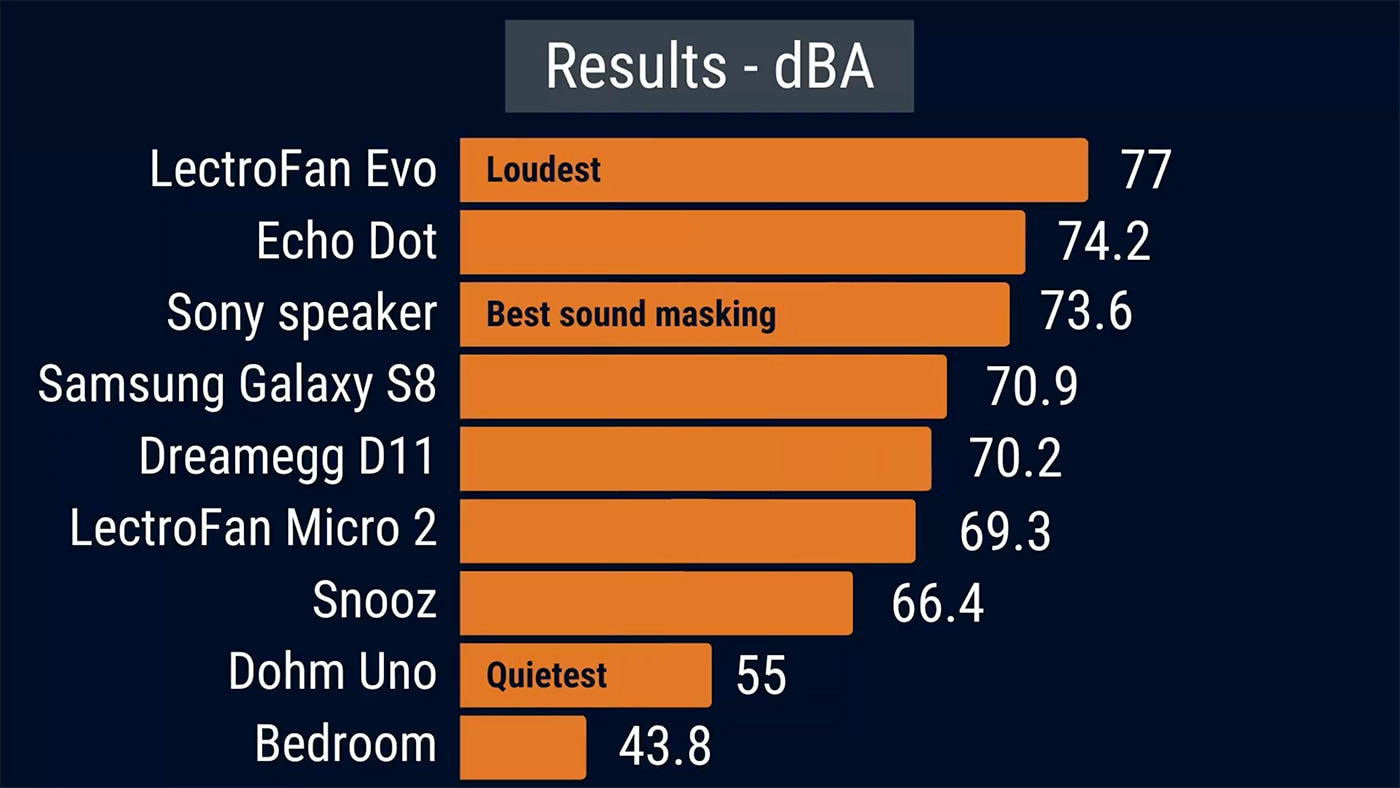
The loudest was the Lectrofan Evo with 77 dBA. Then the Echo Dot third generation with 74.2. The Sony Bluetooth speaker, the SRS-XB12, with 73.6. And that was when it was hooked up to the next one, which was the Samsung Galaxy S8 with the white noise generator app.
The phone speaker alone came out at 70.9. The Dreamegg D11 was 70.2. The Lectrofan Micro 2 was 69.3. The Snooz was 66.4. The Dohm Uno was 55. And finally, the ambient room noise level was 43.8.
It’s worth pointing out that the decibel scale is logarithmic, which means that there’s a considerable difference in sound intensity between even the top two of 77 dBA and 74.2 dBA. And there’s an enormous difference between the loudest at 77 dBA and the quietest at 55 dBA.
Links to buy the white noise machines
If you’d like to find out more about any of the white noise machines or speaker in my test, or buy one, you can find them through these links:
- LectroFan Evo (loudest) – Amazon
- Echo Dot – Amazon
- Sony SRS-XB12 – Amazon
- Dreamegg D11 – Amazon
- Lectrofan Micro 2 – Amazon
- Snooz – GetSnooz.com
- Dohm Uno (quietest) – Amazon
How well they blocked out the air conditioning units and traffic noise
When it came to blocking out the external noise through the window – the air conditioning unit hum and the traffic in the distance – they all did a good job apart from one, unfortunately.
The Dohm Uno was the only one that wasn’t loud enough, wasn’t filling enough in the room to block out the external noise. So that one’s not going to be my top one to recommend for sound masking, based on this test anyway.
How well they blocked out music from another room
When it came to blocking out the Rhythm Is A Dancer remix that I had on my television on repeat next door, the results were more mixed and they fell into three groups I found.
The Dohm Uno, the Snooz, and the phone really didn’t do a very good job of blocking it at all and I could hear everything from the bass to the lyrics.
The Echo Dot, the Lectrofan Evo, the Lectrofan Micro 2, and the Dreamegg D11 all did a pretty good job of blocking out a lot of the sound, but the bass still got through. They just didn’t really take the edge off the bass.
Note: despite my choice of words when I was talking in the video, I think they did take some of the edge off the bass, especially the Echo Dot and the Lectrofan Evo.
The Sony, on its own, was the only one that blocked out the music 100%, even the bass, which really surprised me. However, perhaps I shouldn’t be quite so surprised because it is a Sony speaker after all.
The thing is though, to actually block out the noise successfully and block out the bass, I had to have the Sony speaker on its maximum volume and it sounded really loud. So it’s not something that I would do to help me sleep. It’s not something that I would do during the day for relaxation either, and I wouldn’t recommend it. I don’t think having white noise that loudly for extended periods of time is good for your ears or good for your sanity either if I’m honest!
My own conclusions
So now that I’ve looked at the results, I’m going to make a few of my own conclusions.
Firstly, if you’re looking for a white noise machine and you’re on the fence – you’re not sure whether you really need one; if sound quality, speaker quality, and volume are the things that you’re most interested in then no you don’t really need to buy a machine.
If you’ve got an app on your phone and a decent Bluetooth speaker or any other speaker in the house that you can play through, just stick with those and save yourself some money.
Secondly, if you do want to listen to white noise and you need to block out external noise, if it’s quite loud then I don’t think you’re going to be particularly successful with one that has an internal fan. But if you do want one just for relaxation and you don’t need to block out loud noise, then one with an internal fan is quite a relaxing thing to listen to.
Thirdly, even though I think a smartphone in this test especially has been shown to be quite loud, it doesn’t fill the room with the same level of rich sound. It’s not so filling in the room I found – it’s more directional.
Even though the volume looked quite loud in my test, I wouldn’t recommend it if you’re looking for an overall sound experience. I’d definitely stick with a machine or a Bluetooth speaker.
And then finally, I think white noise has its limitations and it’s worth bearing that in mind. Even though I do reviews of white noise machines and I sometimes recommend it as a way to help people sleep better if external noises is bothering them, I think it really does have limitations.
I wouldn’t recommend listening to white noise night after night as I don’t think it’s particularly good for you. I also find that if you can just find a way to block the noise it’s perhaps better. So for me, that means earplugs generally and sometimes headphones. Just listening to music that you like is perhaps more of an enjoyable experience than blasting white noise night after night after night!
So there you go, I hope that you found this video/article useful and interesting.
Your thoughts
Please let me know what you thought of this test in the comments below. I always really appreciate feedback and opinions. And if there are any other comparisons you’d like to see in the future, I’d love to hear your suggestions.

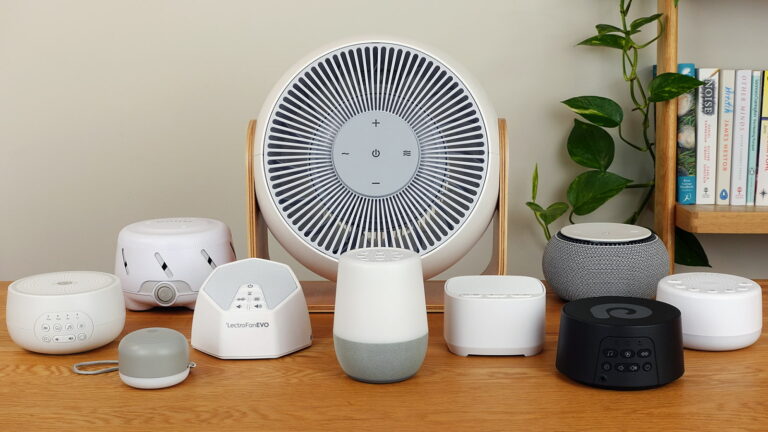
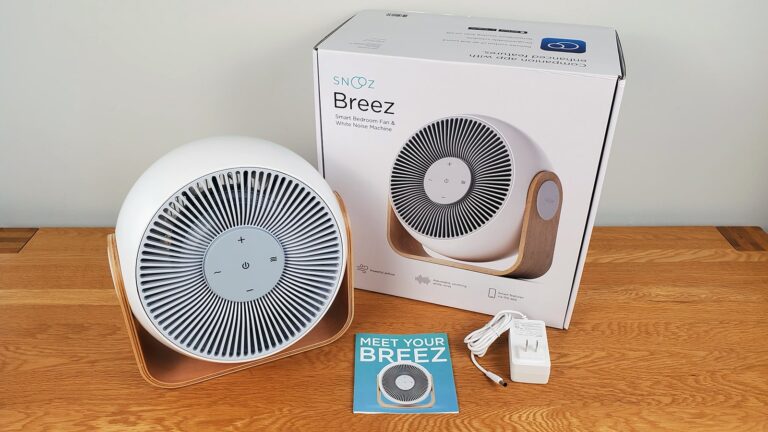
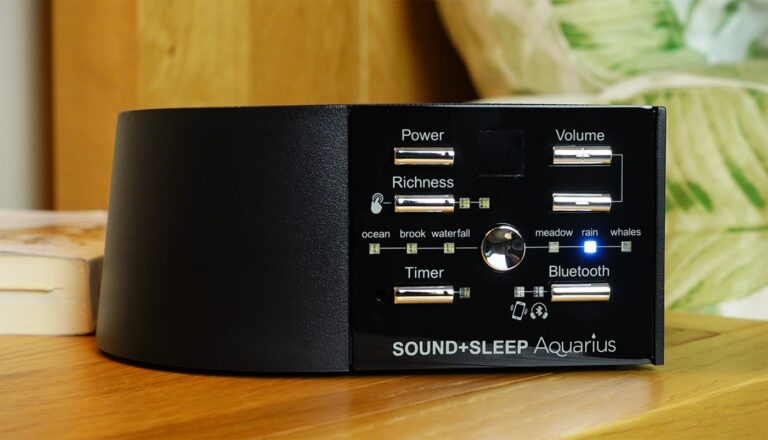
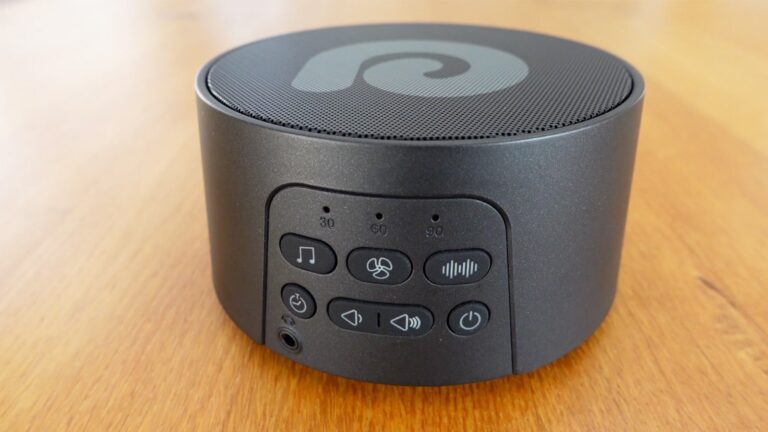
Thank you so much for this. I have been experimenting with spotify and apps through a bluetooth speaker and was wondering if I am missing anything with a dedicated machine. Your research has been valuable.
You’re welcome Scot – I’m glad the article was helpful!
This article was super helpful! It really clarified the differences between white noise machines and app speakers. Thanks for the clear explanations!
You’re very welcome! I’m glad it was helpful.
Just buy a jbl partybox and download an app from the android store and it will drown all noise cause its louder that anything out there lol.
Hi Ed
That’s one way of doing it for sure! White noise played through a large and powerful speaker will drown out a lot.
Regards
Ethan
Good Morning Ethen,
Thank you for the overview and recommendations. I have a unique situation caused by my neighbors pool pump. I recently moved to a retirement community near Phoenix. Like many developments in the southwest homes are built 5′ from the property line. Within this 5′ my neighbor has their pool equipment which runs 16 hours per day. Even though there is a concrete wall on the side there are gates on each end which allow a great deal of noise to escape. I am wondering if I could mount speakers under my eves that I could use white noise to help reduce the pool pump noise that penetrates my home as well as my patio. Your testing of the Sony speaker, use of a white noise app looks promising. I understand noise have a wavelength, can you comment if you think this would help mitigate the noise we hear all day? If you have a recommendation on speakers and application that would also be appreciated.
Thank you!
Hi Jerry
You’re welcome – I’m glad it was helpful.
I think the issue is that if you want to mitigate the pump noise all day, you then have to tolerate white noise all day instead! In theory it would work, depending on how noisy the pump is, the speaker you use, and the type of white noise you use. If you have a way to test the noise masking and your tolerance of continuous white noise with an existing device you have, I’d do that before spending money on new speakers and a mount system. Personally, my preference would be to play music during the day time as that should help mask it too.
Regards
Ethan
Thank you! This information is quite helpful.
You’re welcome, I’m very happy to hear that!
Regards
Ethan